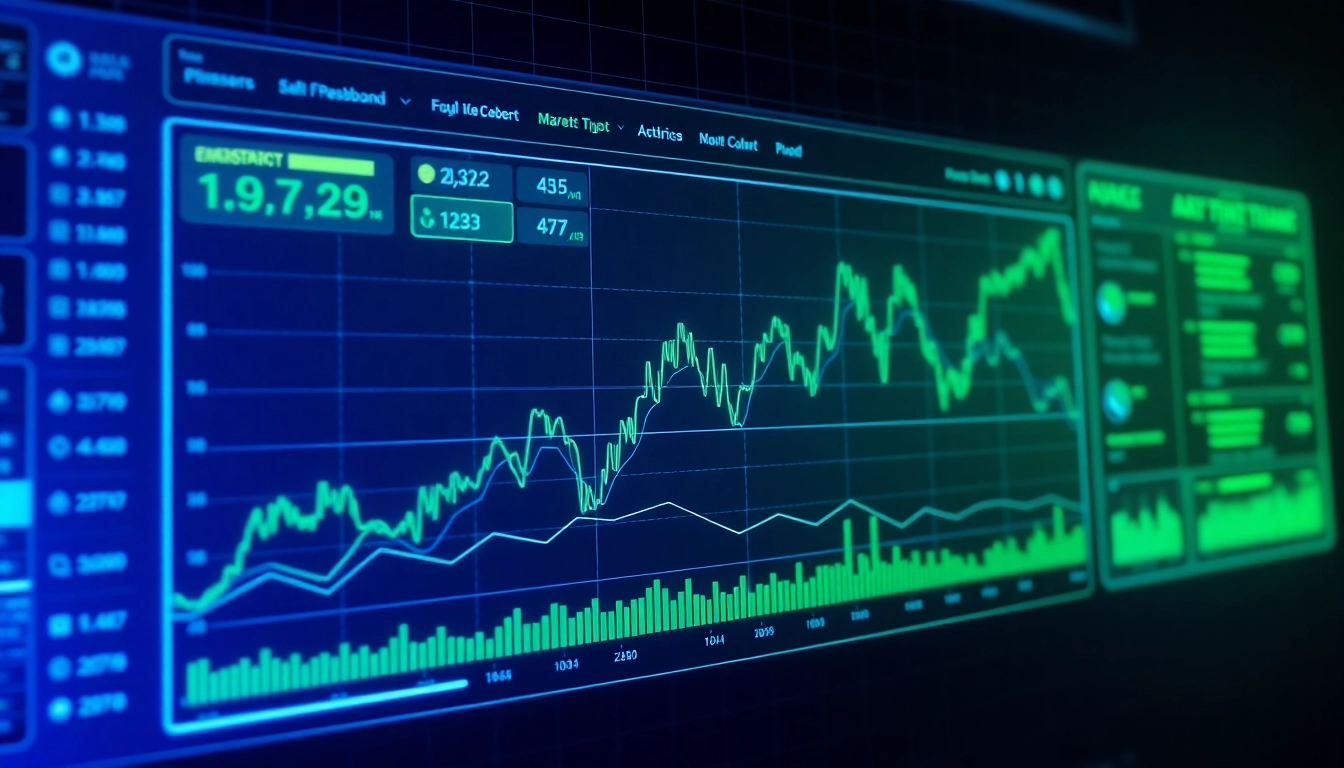Comprehensive Investment News Update: Market Movements, Gold Records, and Strategic Insights
Current Trends Shaping the Global Investment Landscape
The world of finance is in a perpetual state of flux, driven by a complex interplay of macroeconomic indicators, geopolitical developments, technological advancements, and shifting investor sentiments. Recently, markets have experienced a period of mixed signals, with European shares closing marginally higher amid a backdrop of global uncertainties, while gold continues to hit record levels, serving as a safe haven for investors. For those keen to stay ahead in this dynamic environment, understanding the nuanced drivers behind these movements is crucial. To gain comprehensive insights, visit our latest Investment News coverage, which offers real-time updates and expert analysis tailored for strategic decision-making.
Understanding Current Stock Market Trends and Their Impact
Key factors influencing global stocks today
Several core factors are steering today’s global stock markets, including evolving economic data, central bank policies, inflation rates, and geopolitical events. Recently, the U.S. labor market data has played a pivotal role, with strong employment numbers prompting anticipation of Federal Reserve rate adjustments. Meanwhile, European indices shown marginal gains, supported by resilient defense stocks and technology sectors. External pressures such as tensions in China, variations in commodity prices like oil and gold, along with investor risk appetite, also significantly influence daily market fluctuations. Recognizing these factors helps investors navigate volatility and capitalize on emerging opportunities.
Analyzing market fluctuations: bear vs. bull trends
Markets oscillate between bearish and bullish phases, each driven by different catalysts. A bear trend typically signifies widespread investor pessimism, often triggered by economic downturns or geopolitical crises, leading to sustained declines. Conversely, a bull trend reflects confidence in economic growth, often fueled by technological innovation or policy support. Currently, we observe mixed signals, with some sectors recovering while others remain under pressure. For example, the recent record-high gold prices suggest a flight to safety amid market uncertainties, whereas equities show resilience with marginal gains. Identifying these patterns requires technical and fundamental analysis combined with monitoring macroeconomic indicators.
How geopolitical events shape investment strategies
Geopolitical tensions remain a critical consideration for investors. Developments such as US-China trade relations, EU-U.S. economic policies, and internal regulatory changes influence market stability considerably. For instance, recent discussions around tariffs and sanctions have led to volatility in oil and commodity markets, affecting global supply chains. Investors are advised to adopt hedging strategies and diversify across asset classes to mitigate geopolitical risks. Keeping abreast of geopolitical news not only helps in assessing potential market shocks but also enables strategic positioning for long-term growth.
The Rise of Gold: New Records and Investment Opportunities
Recent gold price surges and what they mean for investors
Gold has recently soared past $3,500 per ounce, reaching new historical highs—a clear reflection of heightened market uncertainty and a surge in demand for safe-haven assets. This rally is driven by concerns over inflation, geopolitical tensions, and the potential slowdown of economic growth. Institutional investors and retail buyers alike view gold as a hedge against inflationary erosion and currency devaluation. An understanding of the timing and technical signals, such as breakout patterns, can help investors determine optimal entry points for gold exposure.
Factors driving the precious metal to all-time highs
Several elements have converged to propel gold prices to unprecedented levels. Persistently high inflation rates, especially in the US, diminish the purchasing power of fiat currencies, making gold an attractive alternative. Additionally, global economic uncertainty—exacerbated by geopolitical conflicts and potential recession fears—fuels demand. Central banks’ policies also play a role; many are maintaining dovish stances or engaging in quantitative easing, which weakens fiat currencies and boosts gold’s appeal. Furthermore, hedge funds and institutional investors increasing their holdings have added upward momentum to prices.
Effective ways to include gold in your investment portfolio
Incorporating gold requires strategic planning. Investors can choose physical gold, such as coins or bars, for direct ownership, or opt for financial instruments like gold exchange-traded funds (ETFs) and futures contracts for flexibility and liquidity. Gold mining stocks offer indirect exposure but come with company-specific risks. A balanced approach might involve allocating 5-10% of a diversified portfolio to gold, adjusting according to market conditions and risk appetite. Monitoring technical signals and macroeconomic indicators ensures timing precision, maximizing the benefits of gold’s safe-haven status.
European and US Markets: A Comparative Perspective
European shares’ marginal gains and notable sectors
European markets, represented by indices like the STOXX 600, have closed slightly higher, buoyed by sectors such as defense, technology, and financials. This marginal gain reflects cautious optimism amid ongoing geopolitical uncertainties and inflation concerns. The defense sector benefits from increased geopolitical tensions, while technology stocks continue to capitalize on digital transformation trends. However, weaknesses in energy and banking sectors highlight underlying vulnerabilities. Overall, European markets remain sensitive to global cues, emphasizing the importance of sector-specific analysis.
US stock futures and their correlation with global cues
US futures indicate stability, with traders keeping a close eye on upcoming economic data, especially U.S. labor reports. Positive employment figures can bolster the dollar and increase market confidence; however, fears of interest rate hikes may temper gains. The Fed’s monetary policy stance remains a critical driver, influencing cross-market liquidity and investor risk appetite globally. Contrasts between European and US markets often stem from differing economic resilience and monetary policies, fostering opportunities for diversified strategies.
Impact of U.S. labor data on dollar movement and market sentiment
Recent U.S. labor data indicated a resilient job market, supporting the dollar’s strength as well as boosting investor confidence in the US economy. Strong employment figures tend to reinforce expectations of future rate hikes, impacting bond yields and equity valuations. Conversely, weaker-than-expected data can trigger risk aversion and currency depreciation, prompting investors to seek safe assets like gold. Monitoring labor market releases and interpreting their implications on monetary policy helps investors anticipate short- and long-term market trajectories.
Emerging Trends in Investment News and Financial Innovation
Meta’s partnerships and the future of app integrations
Meta Platforms continues to explore strategic partnerships aimed at enhancing its app ecosystem and monetization pathways. Reports indicate ongoing collaborations, including integrating AI-powered tools to improve user engagement and advertiser targeting. These developments highlight the increasing role of AI and machine learning in digital advertising and social media, transforming how companies interact with users and generate revenue. For investors, understanding Meta’s technological evolution provides insights into the company’s long-term growth potential and new revenue streams.
Cryptocurrency market updates and key developments
The cryptocurrency landscape remains highly dynamic, with Bitcoin and Ether trading flat amid regulatory discussions and market consolidation. Recent SEC actions have slowed trading activity, highlighting uncertainties but also creating buying opportunities for skilled traders. Notably, Bitcoin’s technicals suggest a potential bullish breakout if the 200-week trendline holds, signaling a possible shift to a full bull market. Strategic investors are advised to stay attuned to regulatory developments, technological upgrades, and macroeconomic factors influencing digital assets.
The role of AI and technology in shaping financial news coverage
Advanced AI tools now enable real-time market analysis, sentiment tracking, and personalized news delivery. By automating data aggregation and interpretation, AI enhances the speed and accuracy of financial reporting. This technological shift allows investors and analysts to make more informed decisions, reduce biases, and identify patterns previously unnoticed. Industry leaders are increasingly integrating AI into their research departments, setting new standards for timely and relevant investment news.
Strategic Insights for Investors in Volatile Markets
How to interpret mixed market signals
Deciphering mixed signals requires a balanced approach. Technical analysis, including trendlines and moving averages, helps identify potential breakouts or reversals. Fundamental analysis evaluating macroeconomic data, earnings reports, and geopolitical developments provides context. Combining these methods with sentiment analysis from social media and news feeds allows for a comprehensive view. Staying flexible and maintaining a watchlist of key assets ensures readiness to adapt as clarity emerges.
Best practices for risk management and diversification
Risk management remains paramount. Techniques such as setting stop-loss orders, position sizing based on risk tolerance, and maintaining diversified portfolios across asset classes reduce exposure to adverse moves. Incorporating assets like gold, cryptocurrencies, equities, and fixed income helps cushion volatility. Regularly reviewing and rebalancing allocations ensures alignment with evolving market conditions and personal financial goals.
Planning for long-term growth amid economic uncertainty
Long-term investors should focus on fundamental strength, resilience, and innovation within their holdings. Emphasizing sectors like technology, renewable energy, and healthcare can provide growth opportunities. Staying informed about policy changes, technological breakthroughs, and demographic shifts supports strategic positioning. Additionally, maintaining a disciplined approach—avoiding emotional reactions and sticking to well-crafted plans—maximizes wealth accumulation over economic cycles.



